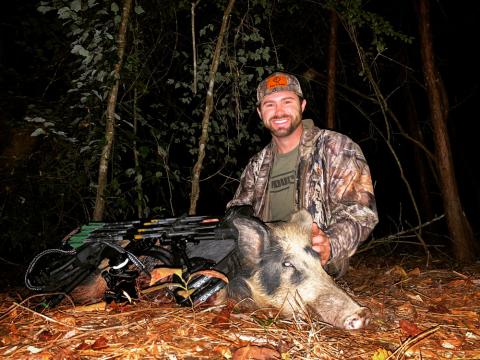Ron Jolly
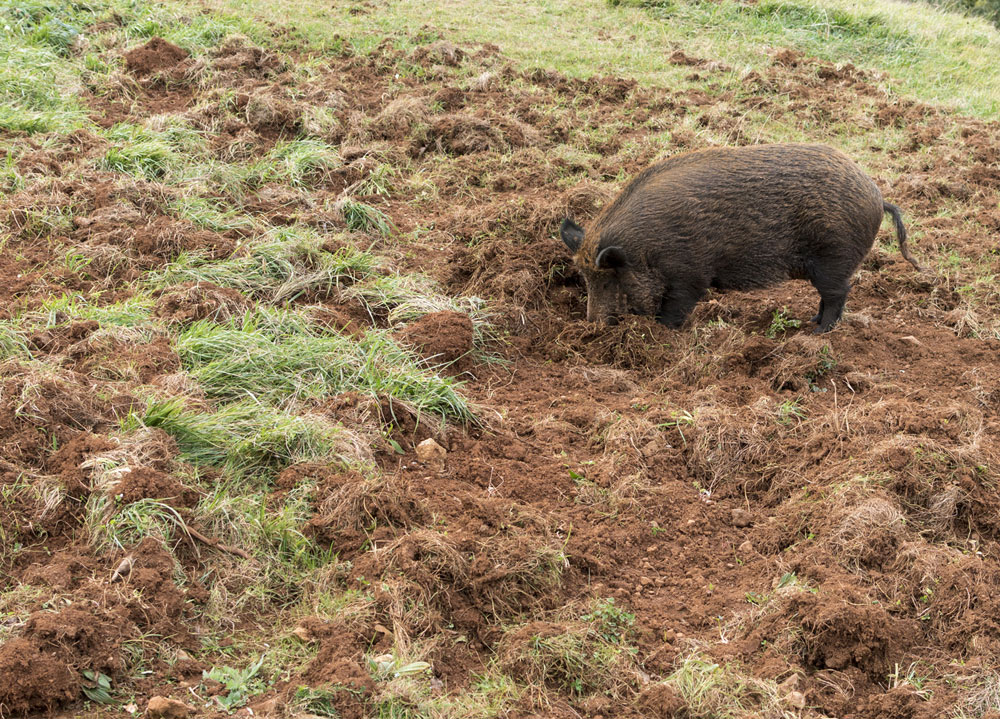
No doubt you are aware of the dilemma facing gamekeepers in the form of feral hogs. You know the destructive nature of these omnivorous mammals and their ability to multiply, survive and thrive. You have heard of the threat they pose as carriers of disease, destruction of habitat and native species.
Over the last two decades feral swine have expanded their range all across the United States. With the spread of hogs comes more destruction to property, agriculture and habitat. It is generally accepted that feral hogs cause around $1.5 billion in damage annually. Many landowners and managers have taken up the torch and fight the hog war on a daily basis.
Innovations in trapping, thermal shooting, helicopter hunting, and regulations for hog control have been implemented to help stem the tide of hog expansion and destruction. It has been proven that 70-percent of the hog population on your property must be removed annually to achieve status quo - seven of every 10 pigs, seven of every 10 sounders! Anything less and you will have more hogs the following year.
Trapping is considered to be the most effective way to eliminate feral hogs. At this time total sounder removal is the accepted concept for control success. Innovative companies have developed technology and equipment to increase the efficiency of trapping these wary, fairly smart animals.
So, with all the effort to control feral hogs, all the technology, all the research, all the heart break of seeing property damaged and crops destroyed, why are hogs still expanding their range? This is the question that must be answered if we ever expect to get a handle on the feral hog dilemma. With that question in mind we asked the experts why, in spite of cutting edge technology and increased awareness of the problem, are feral hogs expanding their range and impact.
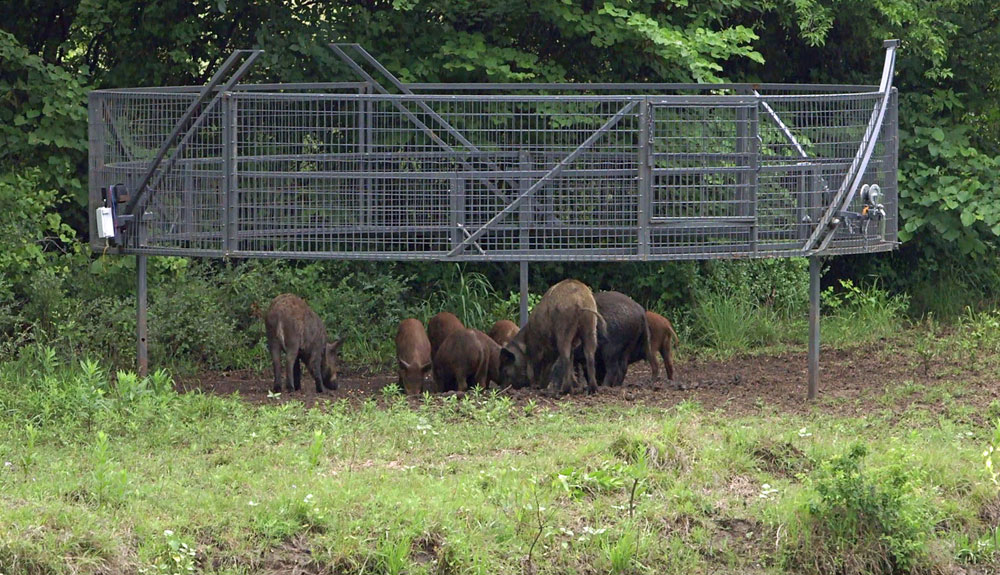
Cody Tomlinson, Business Development Manager, Boar Buster™
“Boar Buster traps are designed with total sounder removal in mind,” said Tomlinson. “Our trap design is unique in that the entire trap is suspended above the ground. Hogs must be conditioned to enter a gate with a threshold. They simply don’t feel comfortable entering a confined space and can take up to two weeks to get comfortable inside conventional traps. Feral hogs do not look up for danger. Our trap allows hogs to enter and exit the trap from any angle so they acclimate to the bait sooner than conventional corral traps.”
“Boar Buster traps are engineered for ease of use. One person can set one up very easily, normally in less than one hour. Unassembled, the trap fits on a small trailer or in the bed of a regular size pickup truck so it is very mobile,” said Tomlinson.
“Our monitoring cameras allow the trapper to observe the hogs in and around the trap via streaming video and give the trapper the advantage of dropping the gate when all the hogs are inside. We are developing new cameras that are more efficient on power consumption and data usage. A monthly service provides data storage and multiple cameras get a discount on the plan. We have never had a customer run out of data between payments because the camera is sending a short message when activated. If you constantly stream video you can use a lot of data but normally the data provided with the service plan is more than enough.”
“When operated according to our instructions, Boar Buster traps are proven to capture 80-percent of the hogs on your property. That’s a great number considering you have to remove 70-percent to maintain status quo. Problem is, if your neighbor is not in the fight you can’t win the war. I think finding like-minded neighbors to share a trap or have one of their own is crucial to getting feral hogs under control.”
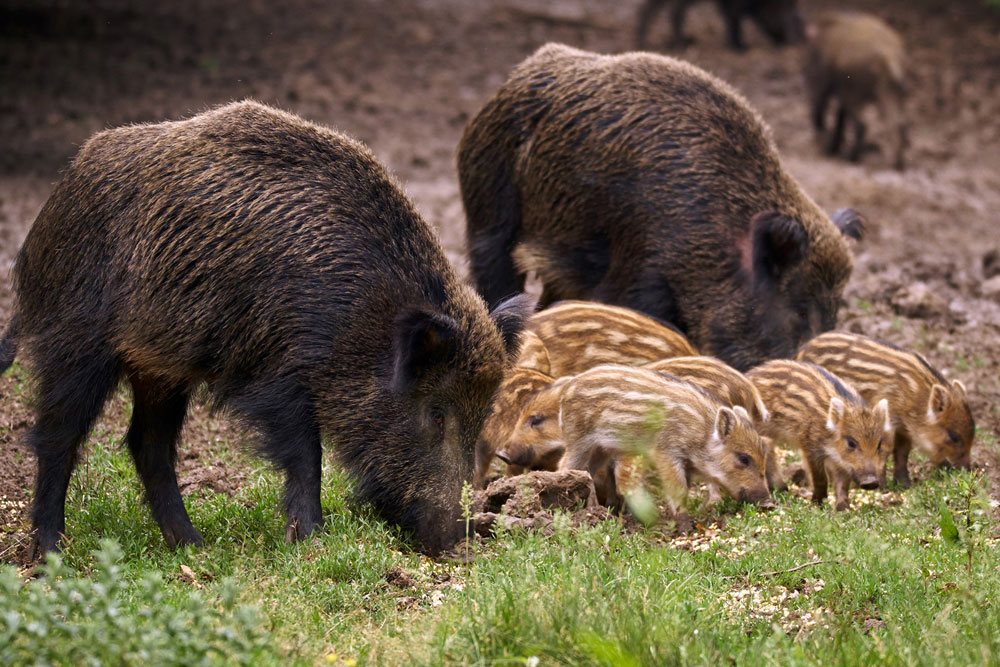
Rod Pinkston, Founder/CEO, Jager Pro™
“Jager Pro pioneered the total sounder removal concept,” said Pinkston. “We have improved our traps with the introduction of portable panels that require no posts and allow one person to set up a trap in less than an hour. We are currently upgrading our cameras from 3G to 4G for faster, more reliable surveillance of traps and these new cameras will feature live, streaming video on demand. Combined with thermal shooting it’s possible to eliminate feral hogs on a piece of property.”
“We have to get away from the damage management perspective and start looking at how we can eliminate hogs on large tracts of 50,000, 100,000 acres or entire counties. To accomplish goals like this you have to have partners and everyone has to be on the same page.”
“One project we are doing involves 16 project partners, everyone from the Georgia Department of Agriculture, Georgia Department of Natural Resources, the University of Georgia and more. Everyone has skin in the game, has a role to play and responsibility to fulfill that role. When you have everybody on the same page, everybody has the same definition of success, and everyone agrees how to accomplish those goals, it’s just a matter of if everybody does their part,” said Pinkston.
“We want to professionalize integrated feral hog control. The solution to the problem is efficient trapping in winter and thermal shooting in spring and summer. We have written a “wild pig control manual” that details all you need to know about controlling hogs. In it, we have established 30 tasks that are required to be a trained, certified hog control operator. We are starting a Hog Control Academy; training will cover everything from trapping techniques to organizing and conducting a meeting of like-minded people who are also interested in controlling feral swine. The ultimate goal is to establish a national standard of what it takes to control this invasive species.”
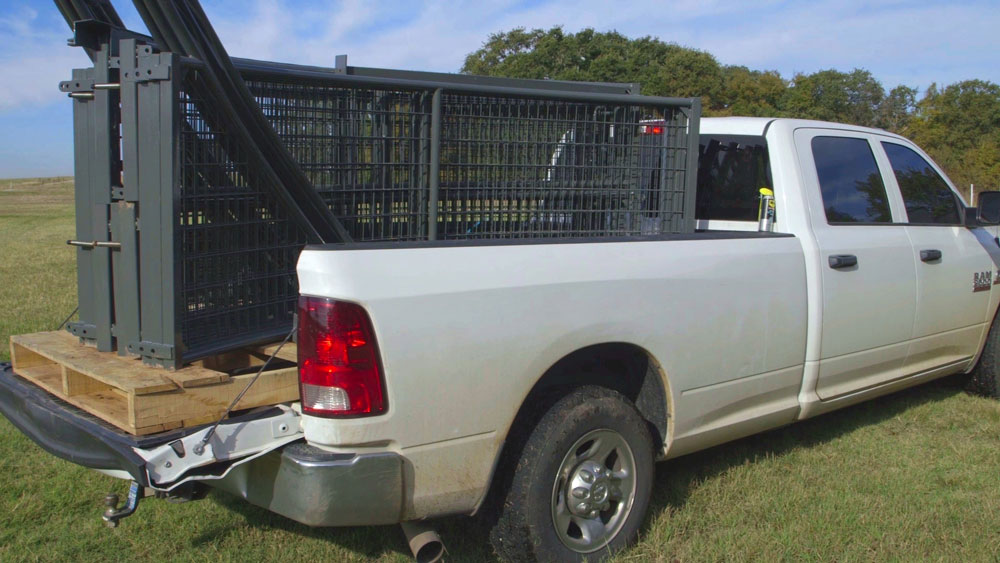
Federal Involvement
The new Federal Farm Bill includes funds to be used for the control of feral swine. Fifteen million dollars each of the next five years is appropriated for feral swine control. That is a total of $75 million. These dollars are to be split equally between the Natural Resources Conservation Service, (NRCS) and Animal and Plant Health Inspection Services (APHIS). Just how that money will be utilized is yet to be determined.
Recently, a listening session involving federal and state agencies, private industry and contractors was held. The three-hour conference call allowed three minutes for anyone invited to participate to call in and voice their opinion. The goal was to form a consensus on how to best spend the federal dollars to achieve the common goal of controlling wild hogs.
At the end of the meeting there was a lot to consider but the general opinion was that the best approach was to tackle ridding large tracts of land or certain watersheds of feral swine. Hope was that if this goal could be attained more federal money would become available to expand the project to more large tracts of land.
As with anything involving the federal government, decisions will come slowly. Hopefully a single concept on the best way to achieve the goal of total hog removal from an area will emerge. If that happens, the way forward should be clear, improvements will be made and the federal dollars will be wisely utilized.
Poisons
If you are one of the unfortunate land mangers dealing with the invasion of feral hogs, you have probably heard that there is ongoing research into the use of poisons to control hogs. This is a touchy subject but one that could be a legitimate answer to the hog problem. Here is what we know.
Warfarin is the compound used in common rat poisons. The product Kaput, is a first generation bait that contains a low dose of warfarin, .005%. It is an anti-coagulant that is lethal to hogs if enough is consumed.
At this time, pen trials conducted by the University of Georgia and other researchers show hogs must consume the poison daily to be effective. Time to mortality in these trials varies from five to eleven days and most hogs die in the seven to nine day period. There was 100-percent mortality in pen trials that peaked at day eight.
The problem with this system is getting free ranging hogs to consume the bait enough consecutive days to be effective. The good news is that in pen trials hogs appeared to enjoy the taste and continued eating it even after fatal amounts were consumed.
Sodium nitrite is a food preservative that is safe for human consumption in small doses. It is fatal to hogs in a single dose. It affects the way blood cells carry oxygen. After consumption hogs lie down to nap and suffocate, usually in sight of the bait station.
One problem with sodium nitrite is the salty taste. Pigs do not like the taste of salt. To be effective sodium nitrite has to be encapsulated to mask the taste. How the encapsulation is affected by weather is part of the ongoing research.
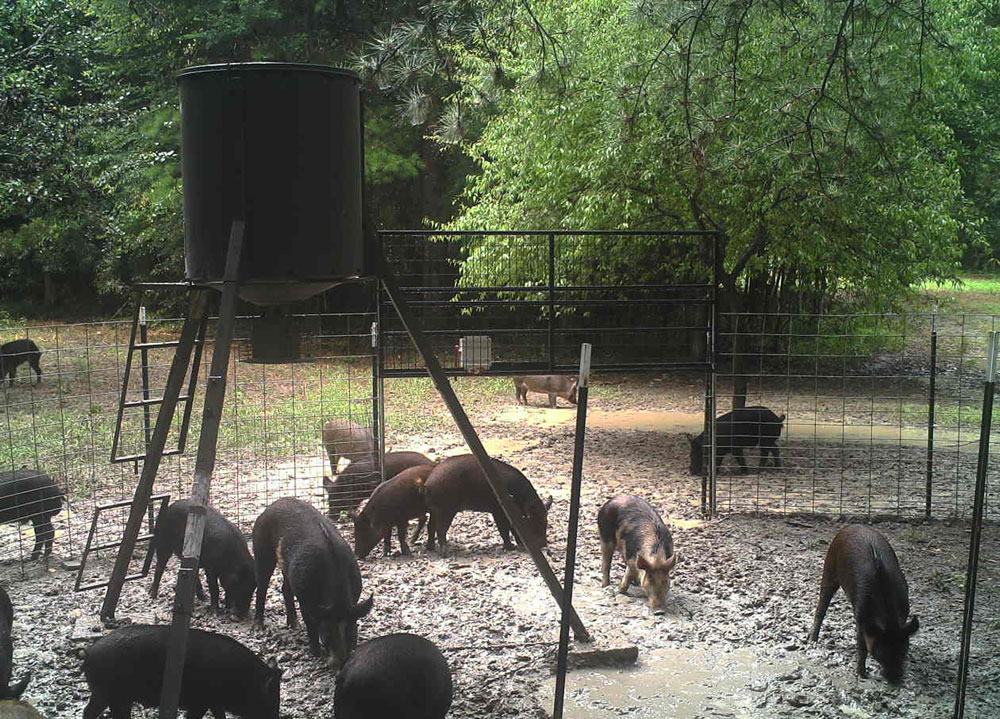
Two field trials were planned to reach some conclusions on sodium nitrite or Kaput. One was planned for the hot, dry climate of Texas and the other for the cool moist, climate of Alabama. The Texas trial was implemented first and during that trial it was discovered that hogs dropped some of the bait during feeding. These droppings were consumed by birds and small animals and had the adverse effect of killing non-target species. The trial was immediately discontinued in Texas and cancelled in Alabama before implementation.
Both of these poisons require a specie specific delivery method or mechanism. This is part of the research. In order for the Environmental Protection Agency, (EPA), to approve and license products like Kaput for feral swine control they must be 95-percent effective and be “species specific.” At this time poisons do not meet those requirements.
The Big Picture
“If everyone adopted the same regulations on how we deal with wild hogs and what to do with them after they are caught or killed we would see progress. In Texas there is a market for wild hogs. In Florida they are used to feed alligators. The reality is ‘it’s meat.’ They are being sold to dog food companies. They have to be careful and make certain the hogs do not have one of the many diseases they might carry, but if there was a place or method for handling pigs once they are caught a lot more people would adopt the trapping mentality,” said Cody Tomlinson.
“I fully believe that if more people combined their effort to eliminate hogs and efficiently operated their traps we could start to get a handle of the hog dilemma,” said Tomlinson. “It will take a big effort in a big area to eliminate feral hogs and total sounder removal is at this time, our best tool for hog control,” said Tomlinson.
“We have proven individuals trapping hogs on only the property they own does not eliminate the big problem,” said Rod Pinkston. “I equate it to “roach control” in a three story apartment building. If you eliminate all the roaches on the second floor and ignore the first and third floor, those roaches are going to migrate to the second floor. You have to eliminate them in the entire building.”
“To do that with hogs everybody has to be on the same page with the same goal. That is why we train feral swine operators to look at the big picture. We train them to all do it the same way. It will take a standardized plan implemented on a large scale to eliminate hogs from large areas such as watersheds, soil conservation districts, counties and then states. We know how to do it, we just need all the stakeholders to get involved,” said Pinkston.
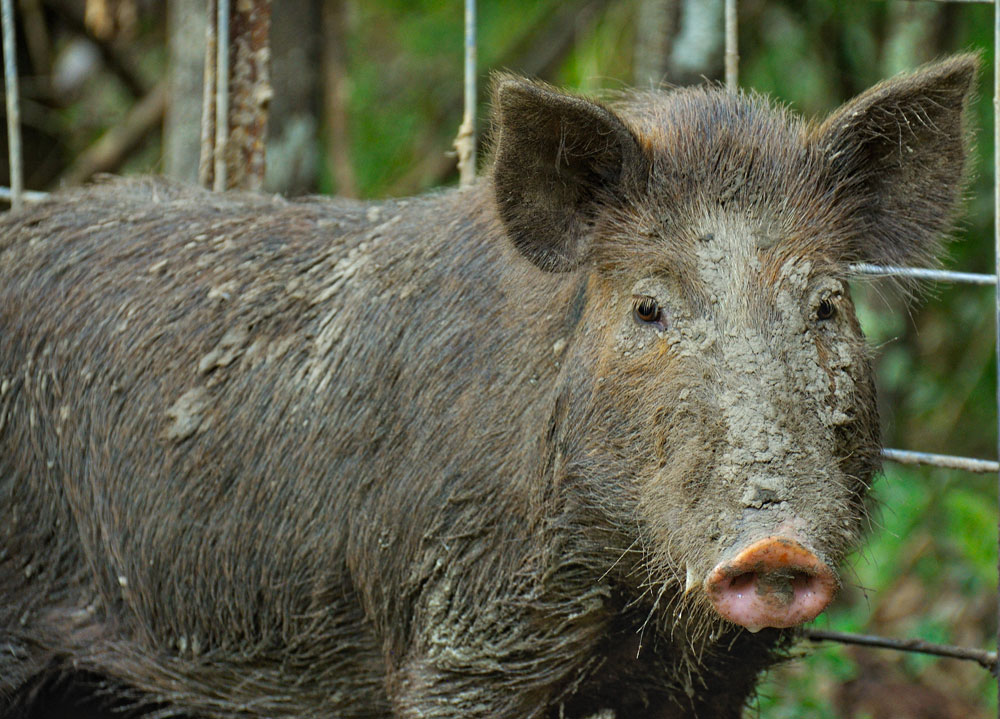
Summary
A lot has been learned in the past decade about feral swine and how to control their spread. The problem is - the solutions are not being applied over enough of the landscape to solve the dilemma. Fact is, at this time, hogs are winning the war.
In Texas, two counties have adopted a “bounty system” on hogs valid through August 9, in Caldwell County, and September 30 in Guadalupe County. To participate you must fill out a W-9 form and a participation form for both counties. A $5 bounty per head for removing wild hogs from the counties will be paid. Accepted proof is a hog tail or certified buying station receipts. It remains to be seen how effective these programs will be, but it illustrates another effort to get the feral hog population under control.
I think we can safely say that until a uniform policy of what it takes to control the spread of and eliminate feral hog populations in large areas and numbers, things will remain much the same. Hogs will continue to spread due to their ability to reproduce at such a high rate and the movement of hogs by people who want to hunt them in their area. With more hogs comes more damage to crops, property and the environment. In the opinion of many experts, the ultimate solution will come when all stakeholders are on the same page with one mission, one method and one definition of success. Let’s hope the current funds appropriated in the new farm bill will be the first step in that direction!

















